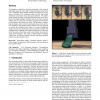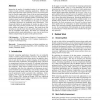97
Voted
TVCG
2008
15 years 18 days ago
2008
This paper presents a new approach for the mesh composition on models with arbitrary boundary topology. After cutting the needed parts from existing mesh models and putting them in...
120
click to vote
TOG
2008
15 years 18 days ago
2008
The goal of this paper is to investigate a new shape analysis method based on randomized cuts of 3D surface meshes. The general strategy is to generate a random set of mesh segmen...
137
click to vote
TOG
2008
15 years 18 days ago
2008
eleton is a very useful 1D structure to abstract the geometry and topology of a 3D object. Extraction of curve-skeletons is a fundamental problem in computer graphics, visualizatio...
103
Voted
TOG
2008
15 years 18 days ago
2008
We introduce a method for efficiently animating a wide range of deformable materials. We combine a high resolution surface mesh with a tetrahedral finite element simulator that ma...
108
Voted
SMA
2008
ACM
15 years 19 days ago
2008
ACM
Improving the quality of tetrahedral meshes is an important operation in many scientific computing applications. Meshes with badly shaped elements impact both the accuracy and con...
158
Voted
SMA
2008
ACM
15 years 19 days ago
2008
ACM
3D mesh models are now widely available for use in various applications. The demand for automatic model analysis and understanding is ever increasing. Mesh segmentation is an impo...
133
Voted
SMA
2008
ACM
15 years 19 days ago
2008
ACM
In this paper we present a new algorithm which turns an unstructured triangle mesh into a quad-dominant mesh with edges aligned to the principal directions of the underlying geome...
111
Voted
SIAMSC
2008
15 years 19 days ago
2008
We describe a hybrid algorithm that is designed to reconstruct a piecewise smooth surface mesh from noisy input. While denoising, our method simultaneously regularizes triangle me...
112
Voted
NETWORK
2008
15 years 20 days ago
2008
IEEE 802.16 mesh mode defines three types of resource scheduling: coordinated centralized, coordinated distributed, and uncoordinated distributed. While the standard defines the r...
JSCIC
2006
15 years 20 days ago
2006
In this paper, a moving mesh discontinuous Galerkin (DG) method is developed to solve the nonlinear conservation laws. In the mesh adaptation part, two issues have received much a...






